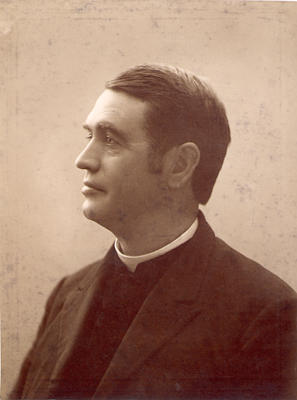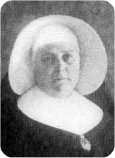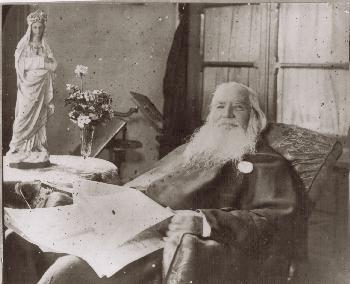
A Cave of Candles / by Dorothy V. Corson


From these letters that mysteriously survived to tell this unfinished story, there was little doubt in the minds of those at the University, that Notre Dame was “doomed” if the dilemma could not be resolved. The country was experiencing the depression years that began with the “Panic of 1893.” It was the fledgling University’s greatest economic crisis. But in the end justice prevailed.
The unauthorized novitiate at Notre Dame was closed but the Sisters of the Holy Cross at Notre Dame were allowed to remain at the convent at Notre Dame. As noted, in the last letter Mother Augusta sent to Fr. Corby, while she was Mother General, St. Mary’s agreed to supply the services of the Sisters to Notre Dame under contract. The lives of these religious women “who lived their hidden lives in the shadow of the Golden Dome” went on as usual, seemingly without interruption, except for those directly involved in the difficulties. Fr. Sorin, Father Walsh and Fr. Granger had passed on, while Mother Ascension, and Sr. Cheribim were sent elsewhere.
The Favor Fr. Corby requested at the Lourdes Grotto in France had been granted and Fr. Sorinís promise to the Sisters in the midst of the melee, “that somehow, sometime, they would return to Notre Dame to continue the work so zealously begun,” had come true. It was typical of the spirit of faith Sorin exemplified throughout his life. The Sisters of the Holy Cross resided at the Convent at Notre Dame on a permanent basis for another 63 years, until 1958, at which time, their mission fulfilled, the Sisters of the Holy Cross at Notre Dame returned to the mother house at Saint Maryís.
In his 1958 pamphlet, Father Hope speaks of the Sisters:
No human effort, however great and lasting can recompense the Sisters of the Holy Cross for what they have done for Notre Dame. . . At one time there were as many as 140 nuns engaged in work at Notre Dame.
Sister Bertina who was known as “Sister Pie;” Sister Lourdes who was called “Sister Coffee;” and Sister Martha who was called “Sister Steak.” The Sisters assumed charge of Father Sorin’s Minims and from their inception in the 1850ís until they were finally disbanded in 1929, the nuns taught and cared for these little boys in all their innocence and deviltry.
 In bidding a last farewell to the Sisters in 1958 in a citation in his book Fr. Hope leaves them with these fond words: “We assure you of our grateful and perpetual remembrance in all our Masses and Prayers and Works; as we know you must have a large share in whatever glory or honor may come to Notre Dame unto the end.”
In bidding a last farewell to the Sisters in 1958 in a citation in his book Fr. Hope leaves them with these fond words: “We assure you of our grateful and perpetual remembrance in all our Masses and Prayers and Works; as we know you must have a large share in whatever glory or honor may come to Notre Dame unto the end.”
Among other letters of gratitude was this one written on May 2, 1958 from Superior General O’Toole to Fr. Hesburgh:
Many of my priest friends over the years have voiced the same sentiments: “Notre Dame would not be here were it not for the Sisters of the Holy Cross.” There is now a parallel to that premise:
The 1896 Our Lady of Lourdes Grotto at Notre Dame would also not be here were it not for the compassion and cooperation of Mother Augusta and her community of Sisters who at the eleventh hour agreed to allow the Sisters of the Holy Cross at Notre Dame to remain in mission on campus. Father Corby’s favor had been granted and his plans to keep his promise to build a replica of the Grotto of Lourdes at Notre Dame began to take shape.
In 1895, [after the election] when the time came for Mother to leave, she had the happiness of knowing that with all her struggle against poverty and after endless difficulties of the hard trying years, there was comparatively little debt left on Saint Mary’s. . . . On a certain occasion she told a Sister, “I have asked God for one thing. What I have had to suffer does not count.” The Sister inquired what she had asked of God. Mother replied, “I have asked Him to fix my Sisters so that no man can ever lay a hand upon them. I asked nothing more. He has done all I asked.”
However, the third and last act to this drama was not yet over. The year of 1896 became a banner year for both Notre Dame and St. Mary’s. In February of 1896 two years after his Memoirs of a Army Chaplain was published, Fr. Corby received the Irish Brigade Flag from Col. James Brady and the Gettysburg Medal he had waited 30 years to obtain for the University.

In the spring of 1896, his favor having been granted, Fr. Corby kept his promise to build a Lourdes Grotto at Notre Dame. With funds donated by his good friend Fr. Thomas Carroll, in May of 1896, Maryís month, he began at once the construction on campus of the present Grotto of Lourdes, modeled after the one in Lourdes, France. It was dedicated on August 5, 1896, the Feast Day of Our Lady of Snows, which coincidentally was also the day Fr. Sorin left France for his mission in the new world. It remains there today one of the most charming and inviting places on campus, a repository of prayers and a symbol of faith and hope for generations to come.
Appropriately, May, 1896, Mary’s month, also brought good news to the campus at St. Mary’s:
Mother Augusta took up the torch passed on by Mother Angela. Only the passage of time has revealed how far ahead of her time she really was. She had dug her heels in and stood her ground as the first Mother Superior General and accomplished what Mother Angela was unable to achieve, their independence and their right of self-government. They finally had the authority to make all their own decisions.
Mother Madeleva records the feelings of the St. Mary’s Sisters in Indiana upon receipt of the long awaited good news: “We older Sisters who knew all she had suffered would have wished, if God had so willed, that she be left with us until the final approval in 1896.” [She was then at St. Cecilia’s in Washington, D.C.]
Mother Augusta died on Christmas Eve, December 24, 1908. Upon her death at the age of 78, a bronze tablet was erected in the vestibule of the community chapel of the Sisters of the Holy Cross at their mother house in Holy Cross, Indiana. It bears this verse from Timothy IV, 7:
|
I have fought the good fight, I have finished the course, I have kept the faith. |
 Mother Madelva explains the bronze tablet:
Mother Madelva explains the bronze tablet:“It commemorates a pivotal character. It marks a crisis and completes an epoch. The character is Amanda Anderson. Out of her story details of both crisis and epoch will emerge.”
The day I was reading the above words from Timothy IV, 7, in the research materials before me, I was sitting at a small desk against the wall in the Convent Archives. As I prepared to record the passage in my notebook, my eyes were drawn to a large framed photograph on the wall above the desk. Sad serious eyes filled with compassion appeared to be gazing down upon me from the Sister in the portrait. When I asked Sr. Katherine Callahan, the Convent Archivist, who the nun in the photograph was, I was surprised to learn that it was Mother M. Augusta. It seemed altogether fitting that in spirit she seemed to be gazing approvingly at my efforts to retell her story.
The Our Lady of Lourdes Grotto on the campus of Notre Dame also marks an epoch in the evolution of the history of both schools. Saint Mary’s College went on to prosper in its own right. It has become a “powerhouse of prayer” and one of the highest ranking women’s colleges in the nation. At this writing, “for the eighth time in the past nine years, Saint Mary’s College was ranked first among the nation’s best Midwestern comprehensive colleges by U.S. News & World Report. It has ranked among the top 10 in its category of more than 100 institutions since the survey began in 1985.”
Since the mid 1960s Saint Mary’s College and the University of Notre Dame have also maintained a Cooperative Co-Exchange Program permitting students to take courses at either institution.
Fr. Corby could not have known what a blessing the Grotto would be to future generations of Notre Dame and St. Mary’s students, their families, and friends of Notre Dame. Mary, and the spirit of her faith, continues to heap Heavenís Blessings on her domain on both sides of “the road to Niles.” And they are still flowing even now over 100 years later.
Anyone who lights a candle of hope at Our Lady’s Grotto, or in their heart, is keeping the spirit of Mary’s faith alive for everyone who visits there. The Grotto’s presence on the Notre Dame campus has also become a symbol of reconciliation because without the cooperation of both institutions and the fervent hopes and prayers left at the Our Lady of Lourdes Grotto in France, Notre Dame's Lourdes Grotto would not exist on the campus today.
 Even in Sorinís darkest moments when the survival of the University was in jeopardy, his faith in Our Lady never faltered. During one of his last illnesses, in the midst of all the trouble and travail, his intrepid spirit was still in evidence.
Even in Sorinís darkest moments when the survival of the University was in jeopardy, his faith in Our Lady never faltered. During one of his last illnesses, in the midst of all the trouble and travail, his intrepid spirit was still in evidence.
“As he lay in his reclining chair he could turn his head and see, the golden dome and Our Lady surmounting it. He scribbled a note in his shaky hand and addressed it to Father Thomas Walsh, CSC, the then president of the University. ‘This morning, I have been looking at Our Lady. I am now as certain as it is possible to be certain that with the aid of Our Blessed Mother, under whose image we are living, our University will prosper.’”
Fr. Sorin often referred to the curves and disappointments in life as “Providential Interferences” to lead us to the path we were meant to take. In the last months of his life when he, himself, was most vulnerable, his faith in his vision of the future of his University never wavered though he knew he would not live to see it.
True to Sorin’s words, the University of Notre Dame continued to prosper beyond anything he could have envisioned. At this writing it has been ranked in the top 20 universities in the nation in both athletics and academics.
Father Hope put it all in its proper perspective in these lines from his book, Notre Dame One Hundred Years (University of Notre Dame Press, 1948) in which he described Fr. Sorin’s funeral:
At this point, Fr. Sorin’s own words mentioned earlier in this story deserve to be repeated:
Sorin’s words echo the thoughts of Edmund S. Morgan, Sterling Professor of History at Yale University. At age 86 he has written an acclaimed biography on the life of Benjamin Franklin. During an interview about his book, he said, “I never intended to write a book, I got carried away by Benjamin Franklin.” Professor Morgan gave this definition of an Historian:
-- Professor Edmund S. Morgan
I know that feeling only too well. I got carried away by the Spirit of Notre Dame and all the interesting unexpected connections I made in researching its history. It is so true, the deeper you dig the more you will find.
Now, over 100 years later, the story behind the crisis that inspired the Our Lady of Lourdes Grotto at Notre Dame, has surfaced and deserves to be retold for the unfinished good that has continued to evolve from it. The Notre Dame Grotto has not only become a symbol of the faith and hope upon which Notre Dame and Saint Mary’s were founded but also of the reconciliation that became the “Favor Granted” to Fr. Corby that gave it birth. A reminder that sometimes sad things have to happen so the good can shine through, and all’s well that ends well.
The good continues to shine forth from the candleglow at the Grotto. Day and night throughout the seasons its gleaming candles have been a comfort and an inspiration to countless generations of faithful visitors since the day it was dedicated on August 5, 1896.
In the President’s Mansion at the University of Alabama a lovely painting titled, “Above the Clouds at Sunrise” is installed in the dining room. A plaque in the entry hall commemorates the 1997 refurnishing of the Mildred Warner House by its benefactors, Elizabeth & Jack Warner. The mansion is filled with American paintings and finely crafted early American furniture. On a plaque in the entry hall are these words: “Any great university should have a gem that lifts the soul above the clouds.”
At the heart of Notre Dame’s picturesque campus, nestled in a gentle hillside among the trees and landscaped lakes, is such a gem -- a group work of art -- “that lifts the soul above the clouds.” This peaceful wayside shrine has become a place of charm and enchantment for all seasons, a pleasing artistic adaptation to its surroundings, a place for prayer and quiet reflection. May it ever be so. And may it continue to inspire visitors for generations to come.

|
Lighting a candle of hope at the Grotto |
Dorothy V. Corson
Lourdes Day,
2003